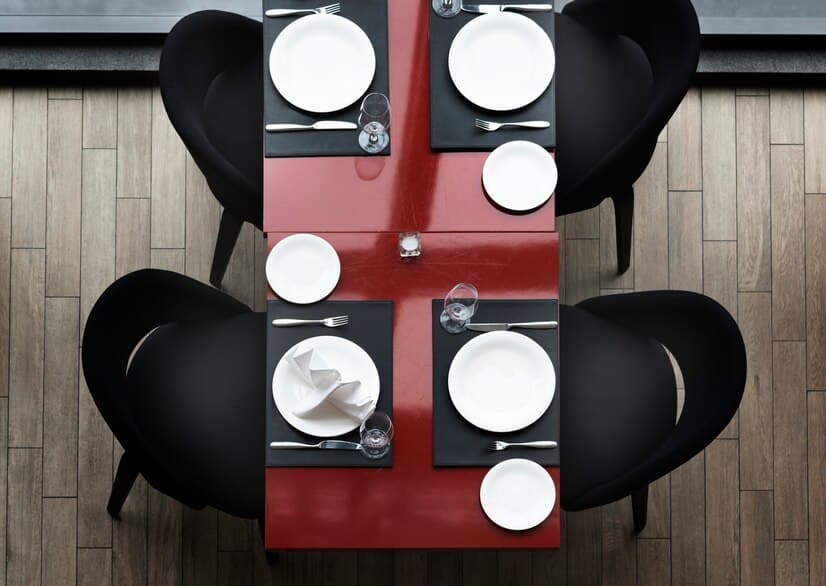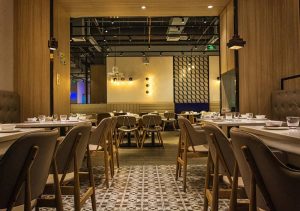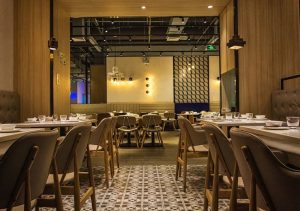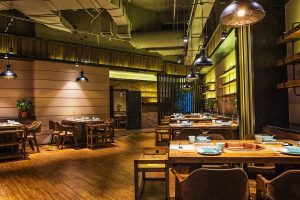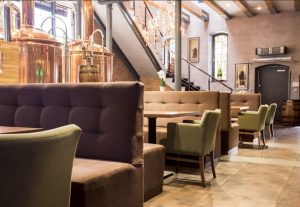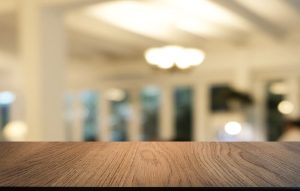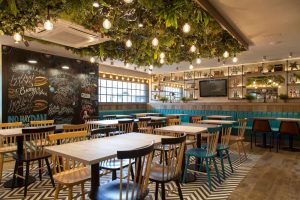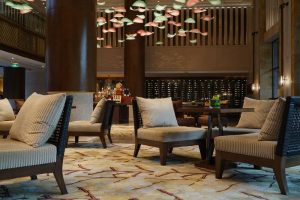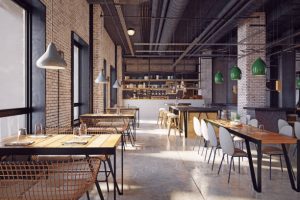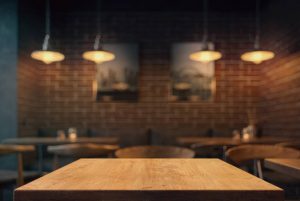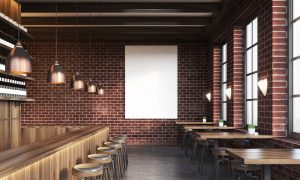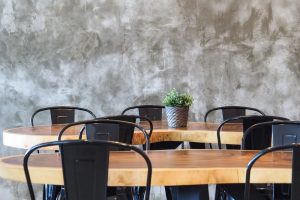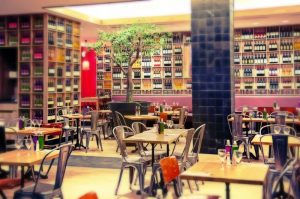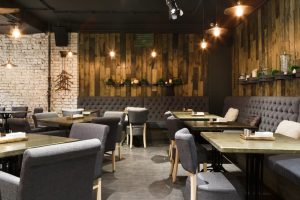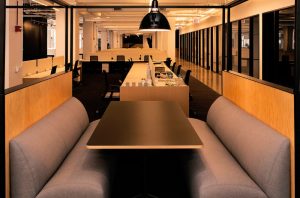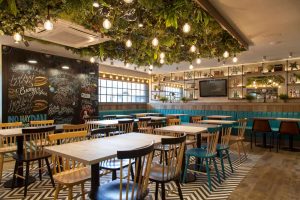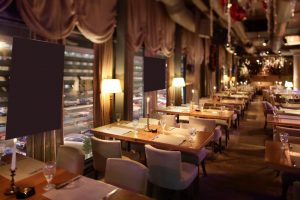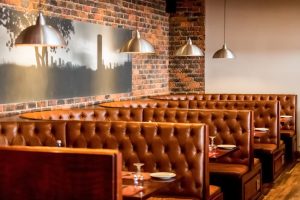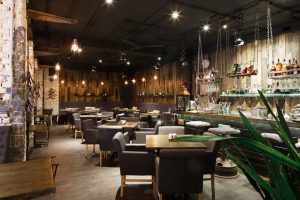The restaurant furniture layout plays a vital role in customer experience, operational efficiency, and overall ambiance. A well-structured layout ensures that guests feel comfortable, staff can move freely, and the restaurant maintains a balanced atmosphere between functionality and style.
An optimized restaurant furniture layout directly impacts seating capacity, space utilization, and revenue generation. Whether you run a fine dining restaurant, casual eatery, or a fast-food establishment, the right layout enhances comfort, workflow, and customer satisfaction.
In this guide, we will explore the best practices for arranging restaurant furniture, the most effective seating arrangements, and how to maximize space while maintaining a stylish and welcoming environment.
Table of Contents
Toggle- Key Factors in Designing an Effective Restaurant Furniture Layout
- Best Restaurant Furniture Layouts Based on Dining Style
- Designing for Comfort: Space Optimization and Traffic Flow
- Enhancing the Aesthetic Appeal of Your Restaurant Layout
- Final Thoughts on Restaurant Furniture Layout
- 4 Tips for Furnishing your Restaurant
- How to furnish a restaurant
- How to choose furniture for your restaurant
- What is the role of color in restaurant interior design?
- Most popular wood types for restaurant furniture
- How to choose the right tabletop material
- Psychology of Restaurant Designs
- How to Choose Timeless Furniture for your Hotel
- Turkish Restaurant Furniture Options
- Restaurant Furniture Istanbul
- Restaurant Bar Chair Ideas from Turkey
- Metal or Plastic Chair for your Restaurant in Turkey
- Restaurant Chair Produced in Turkey for Indoor and Outdoor
- Selecting Restaurant Tables Made in Turkey
- Designing Restaurant Booth Seating From Turkey
- 7 Things to Consider Whilst Designing a Restaurant Furniture Layout
- The Guide to Planning and Buying Restaurant Tables and Chairs Made in Turkey
- Advantage of Booth Seating Made in Turkey
- What type of restaurant chair should you prefer – wooden, metal, or plastic?
- Building A Unique Atmosphere
Key Factors in Designing an Effective Restaurant Furniture Layout
1. Understanding Your Restaurant’s Space and Theme
Before selecting tables, chairs, and booths, it’s important to analyze the overall space, theme, and target audience. The type of restaurant furniture layout you choose should match the restaurant’s concept.
Fine dining restaurants require spacious seating arrangements to create a luxurious experience.
Cafés and casual diners benefit from flexible seating that accommodates various customer preferences.
Fast-food restaurants need efficient layouts that allow for quick turnover and easy cleaning.
Tip: Consider the balance between open spaces and seating density to create a comfortable and visually appealing environment.
2. Optimizing Seating Capacity Without Overcrowding
A restaurant must maximize seating capacity while ensuring that guests do not feel cramped. The key is to balance efficiency and comfort to encourage longer stays and repeat customers.
Standard spacing recommendations:
- Between tables: 24–30 inches for easy movement.
- Between chairs: 18 inches for guest comfort.
- Walkways: 36–42 inches to allow smooth traffic flow.
Tip: Use booths along walls and smaller tables in the center to optimize space without compromising the dining experience.
3. Choosing the Right Type of Restaurant Furniture
Selecting functional and stylish furniture is crucial for an efficient restaurant seating arrangement. The right mix of tables, chairs, and booths creates a welcoming atmosphere while maintaining practicality.
Tables
Round tables encourage conversation and work well for small groups.
Square and rectangular tables maximize space efficiency and flexibility.
Communal tables create a social dining experience in modern settings.
Chairs and Seating Options
Upholstered chairs enhance comfort in upscale dining establishments.
Wooden or metal chairs provide durability for high-traffic restaurants.
Booth seating offers a cozy and space-saving option for maximizing the layout.
Tip: Choose stackable or foldable chairs for flexible seating arrangements in multi-purpose dining spaces.
Best Restaurant Furniture Layouts Based on Dining Style
1. Fine Dining Restaurant Layout
Prioritizes privacy, elegance, and spacious seating.
Uses round tables for intimate dining and luxurious booths for VIP sections.
Incorporates high-end materials like wood, marble, or leather.
Tip: Allow at least 36 inches between tables to maintain a sense of exclusivity.
2. Casual Dining and Bistro Layout
Features a mix of booths, two-person tables, and communal seating.
Encourages a relaxed yet social environment.
Uses simple, functional furniture with a modern aesthetic.
Tip: Arrange tables in clusters rather than rows for a more inviting atmosphere.
3. Fast-Food and Quick-Service Layout
Focuses on high seating turnover with compact, easy-to-clean furniture.
Uses fixed seating or bar-style counters for grab-and-go customers.
Ensures a clear traffic flow from ordering to seating.
Tip: Optimize the space with modular furniture that adapts to peak and off-peak hours.
Designing for Comfort: Space Optimization and Traffic Flow
1. Balancing Open Spaces and Seating Density
Avoid overcrowding tables, which can lead to discomfort and poor service flow.
Maintain open sightlines to allow staff to monitor guests easily.
Arrange seating to maximize natural light and ambiance.
Tip: Use mirrors and light-colored furniture to make smaller spaces feel larger and more inviting.
2. Creating a Smooth Traffic Flow
Designate clear paths for servers and guests to avoid congestion.
Position the cash register and bar area strategically to minimize bottlenecks.
Keep high-traffic areas free from obstructions.
Tip: Apply floor markings or decorative partitions to guide guests naturally through the space.
Enhancing the Aesthetic Appeal of Your Restaurant Layout
1. Choosing the Right Color Scheme
Warm tones (reds, oranges) stimulate appetite.
Cool tones (blues, greens) create a relaxing atmosphere.
Neutral colors (beige, gray) balance elegance with simplicity.
Tip: Use accent walls and lighting features to add personality and depth to the space.
2. Lighting and Ambiance
Soft lighting creates intimacy in fine dining restaurants.
Bright lighting works best for fast-casual settings.
Adjustable LED lighting allows mood customization for different dining hours.
Tip: Add decorative pendant lights to highlight key areas like the bar or central dining space.
Final Thoughts on Restaurant Furniture Layout
An effective restaurant furniture layout is essential for customer satisfaction, efficient service, and overall business success. Whether designing a fine dining experience, a casual café, or a fast-food chain, a well-structured layout enhances comfort, movement, and aesthetics.
Key Takeaways:
Balance seating capacity and comfort to optimize guest experience.
Choose durable, stylish furniture suited to the restaurant’s theme.
Maintain open pathways and smooth traffic flow for seamless service.
Incorporate lighting and color schemes that enhance the ambiance.
Use flexible seating arrangements to accommodate different dining needs.
By carefully planning your restaurant furniture layout, you can create a functional and inviting dining environment that attracts customers and enhances their overall experience.
4 Tips for Furnishing your Restaurant
Furnishing a restaurant goes beyond choosing tables and chairs; it...
Read MoreHow to Furnish a Restaurant
Furnishing a restaurant is about more than just selecting tables...
Read MoreHow to choose furniture for your restaurant
When opening or renovating a restaurant, one of the most...
Read MoreWhat is the role of color in restaurant interior design?
The role of color in restaurant interior design is one...
Read MoreMost popular wood types for restaurant furniture
When selecting restaurant furniture, wood remains one of the most...
Read MoreHow to choose the right tabletop material
Choosing the right tabletop material is crucial when selecting furniture...
Read MorePsychology of Restaurant Designs
When constructing a restaurant, there are numerous factors to take...
Read MoreHow to Choose Timeless Furniture for your Hotel
Timeless furniture for your hotel is one of the most...
Read MoreRestaurant Furniture Istanbul
We are operating professionally in the field of restaurant furniture...
Read MoreRestaurant Bar Chair Ideas from Turkey
When designing a restaurant or bar, seating is a crucial...
Read MoreMetal or Plastic Chair for your Restaurant
Metal or Plastic Chair for Your Restaurant: Finding the Right...
Read MoreRestaurant Chair for Indoor and Outdoor
Selecting the right restaurant chair produced in Turkey for indoor...
Read MoreSelecting Restaurant Tables Made in Turkey
If you seek to add finishing touches to your restaurant...
Read MoreDesigning Restaurant Booth Seating From Turkey
If you have procured a restaurant booth seating made in...
Read More7 Things to Consider Whilst Designing a Restaurant Furniture Layout
Getting a good review for your restaurant is not solely...
Read MoreThe Guide to Planning and Buying Restaurant Tables and Chairs Made in Turkey
If you are a potential restaurant owner, planning and buying...
Read MoreAdvantage of Booth Seating Made in Turkey
It is no gainsaying that Turkish-made Booths are taking center...
Read MoreWhat type of restaurant chair should you prefer – wooden, metal, or plastic?
Immediately a guest steps into your hospitality outlet, your furnishings...
Read MoreBuilding A Unique Atmosphere
Today dining has become fashionable so customers expect to have...
Read More

